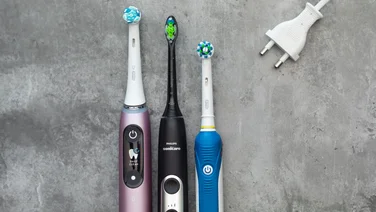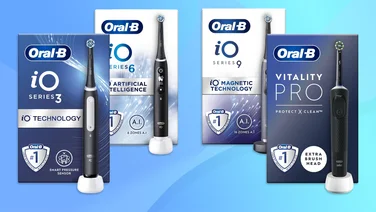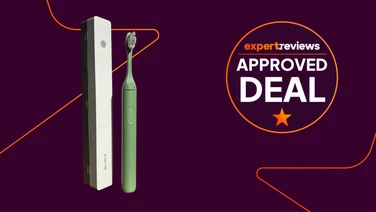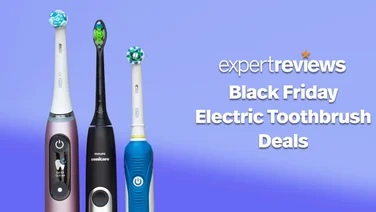To help us provide you with free impartial advice, we may earn a commission if you buy through links on our site. Learn more

Toothbrush adverts on TV might suggest that electric toothbrushes are better than manual ones, but there’s a surprising amount to think about when it comes to making the switch. Take the time to make the right choice for you, and you can improve your oral hygiene and help to avoid unwanted trips to the dentist.
To clear up any questions you might have, we’ve written a comprehensive guide. If you’re wondering whether to switch to an electric toothbrush, read on, and we’ll cover all the frequently asked questions and arm you with all the information you need to make a buying decision.
What makes electric toothbrushes so great?
After years of speculation, a study that was published in 2019 finally laid any doubts to bed about what toothbrush you should be using. Scientists found after an 11-year research period that people who used electric toothbrushes had healthier gums, less tooth decay and also kept their teeth for longer, compared to those who used manual ones. It’s no surprise that almost 50% of British adults have an electric toothbrush in their bathroom cabinet.
Dentists and oral hygienists say that thanks to the rotating or “oscillating” heads on many modern electric toothbrushes, they’re more likely to give a precise and thorough clean than a traditional toothbrush. While it is theoretically possible to do a perfectly decent job with a standard toothbrush, that requires good technique and consistency – an electric model guarantees a more thorough brushing with a minimum of effort, therefore plaque is removed more easily and gum disease is kept at bay.
What can new technology do for me?
Moreover, technology in electric toothbrushes has come on leaps and bounds since they started appearing on shelves. Many models now alert the user if they’re applying too much pressure to their pearly whites. After all, brushing too hard can damage enamel and cause receding gums, which is something even the fanciest toothbrush can’t reverse.

Another useful feature that’s common in electric toothbrushes is an integrated timer which cuts the power out after 2 minutes, and intermittently pauses it in certain intervals, telling the user to move from one zone of the mouth to the next. This is a great mental reminder when brushing, because it ensures one area of the mouth isn’t getting more concentration than another, guaranteeing an even clean. For some people, keeping a brushing session to 2 minutes can be quite difficult, whether they go on for longer or struggle to stretch out the process longer than 90 seconds. Integrated timers help that process because they either hurry you along or cut things short depending on your personal timings.
Furthermore, electric toothbrushes make correct brushing technique nice and easy. “Modified Bass Technique” may sound like something you’d learn about while studying music production, but we promise it’s something that’s recommended by a lot of dental care professionals. This technique involves cleaning each tooth in small circles at a 45-degree angle, which will effectively remove plaque and other food debris from the surface of your fangs, while also offering a gentle massage to your gums at the same time. This is, of course, an achievable technique while using a manual brush, but it becomes much easier with an electric one.
READ NEXT: Best mouthwash
Why do electric toothbrushes use such small brush heads?
If you haven’t made the leap to electric toothbrushes yet, those smaller brush heads can seem like quite a daunting adjustment. Surely they would make cleaning teeth a harder experience, so why do so many manufacturers use them?
Smaller brush heads allow you to clean harder-to-brush areas within your mouth. The long necks of changeable brush heads can reach your back teeth with ease, while the smaller heads themselves can clean small crevices and wisdom teeth, which are often neglected.

That’s not all – longer necks on these brush heads are great for people who struggle with mobility and dexterity, so that’s something to consider if that at all applies to you. The ability to change these brush heads out is also a real benefit if you’re on a budget. A lot of the electric toothbrushes on the market have varying brush heads for different functions, and are often colour-coded. This means you can share a toothbrush with someone you live with and easily keep track of which brush head is yours and which is theirs.
For some, these small brush heads just don’t cut it. However, with the market expanding, there are a growing number of electric models with a more traditional head shape. When one you prefer becomes available, we recommend you give it a try.
What are the benefits of a manual brush?
Electric toothbrushes tend to be larger, heavier, and more awkward to travel with. If you don’t want to cart an electric toothbrush (and charger) around, it’s a good idea to have a manual toothbrush that you can take on the go.
Manual toothbrushes typically have a longer, more traditional brush head shape as opposed to the smaller, circular shape we’ve already discussed. Depending on the shape of your mouth, teeth, and gums, these more traditional head shapes may be better suited for you.
If you’re still hesitant to make the switch from manual to electric, there are always half-steps. Oral-B make some very popular – and affordable – battery powered toothbrushes with the design of manual ones. These allow you to get some of the efficiency of the oscillating electric heads without compromising on a more familiar head shape.
What about for kids?
All the fun technology and functionality in electric toothbrushes can be a great way to create interest in dental and oral hygiene from an early age. With many manufacturers supplying specialised makes and models specifically for kids, an electric toothbrush can be something they benefit from, even if they’re still on their first set of gnashers.

Instilling healthy dental habits early is so important for kids, and having electric toothbrushes that prompt more curiosity and questioning can be a great way of doing that. Having said that, even with a junior electric brush, we’d still recommend double-checking their teeth to make sure they’re brushing correctly.
Are there any other brushing tips to be aware of?
According to dentists, you should brush your teeth for around 2 minutes, twice a day. Whether you use an electric toothbrush or a manual one, it’s important to keep to a good dental hygiene routine.
While brushing, you should try to get each tooth clean from every angle – a lot of people forget to brush the sides of their teeth that face inwards toward the mouth, and this is where a lot of bacteria can build up.
It’s important to be thorough, but try not to apply too much pressure when brushing, as this can lead to enamel wear and tear, which is another thing you don’t want. Cleaning your tongue is highly recommended, too, as the tiny hairs on its surface can hold onto bacteria that can cause nasty-smelling breath.
Brushing before bed and before breakfast are two highly recommended times. Before breakfast is preferable because it gives your mouth an extra line of defence against breakfast foods, which are often acidic.
READ NEXT: Best teeth whitening kits
What about toothpaste, mouthwash and floss?
To find the best toothpaste for you individually, it’s recommended that you consult your dentist. The majority, however, will recommend a paste with fluoride in it, as this is an important ingredient that will help to rebuild any weaknesses your teeth may have. The same goes for mouthwash.
Giving your teeth a bath with mouthwash and cleaning in between your teeth are two vital parts of oral hygiene. Again, fluoride is recommendable, and when it comes to floss, you should try to do this once daily.
If flossing isn’t the most appealing process to you, there are now numerous water flossers and alternative interdental brushes that may suit you better.






